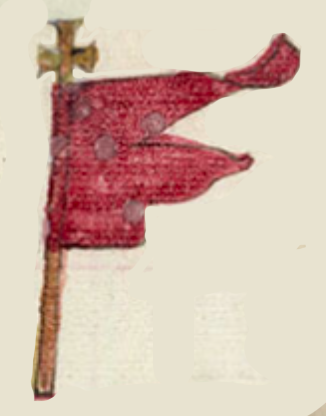Santiago (CST39)
This painting of the simplex glyph for the saint’s name, Santiago (taken as a loanword into Nahuatl) shows a red flag in profile, flying toward the viewer’s right. By waving, it shows three-dimensionality and movement. The companion text (transcribed and translated by Kevin Terraciano, Codex Sierra, 2021, 124 and 158) explains that 26 pesos were spent for the feast day of Santiago, when many Indigenous rulers (tlatoque, or tlahtoqueh with the glottal stops) came to visit, apparently from other towns.
Stephanie Wood
It may seem ironic that St. James, the patron saint of the Spanish invaders and colonizers of Mexico, came to be popular with Indigenous leaders. But many of them had allied with the colonizers to help spread the Spanish empire in different parts of what had been the Aztec empire and beyond. See the book Indian Conquistadors, Laura L. Matthew and Michel R. Oudijk (2014). See the iconographic image for a Spanish expedition where the leader is on horseback and carries a red banner: Florida (Osu8r), below. That was an expedition that involved Spaniards and central-Mexican Indigenous warriors who were complaining that they were not paid. Many of them died.
Stephanie Wood
señor santiago
Señor Santiago
1550–1564
Jeff Haskett-Wood
santos, religión católica, Mataindios

Santiago, St. James, https://nahuatl.wired-humanities.org/content/santiago
Santiago
Stephanie Wood
Códice Sierra-Texupan, plate 39, page dated 1561. Origin: Santa Catalina Texupan, Mixteca Alta, State of Oaxaca. Kevin Terraciano has published an outstanding study of this manuscript (Codex Sierra, 2021), and in his book he refers to alphabetic and “pictorial” writing, not hieroglyphic writing. We are still counting some of the imagery from this source as hieroglyphic writing, but we are also including examples of “iconography” where the images verge on European style illustrations or scenes showing activities. We have this iconography category so that such images can be fruitfully compared with hieroglyphs. Hieroglyphic writing was evolving as a result of the influence of European illustrations, and even alphabetic writing impacted it.
https://bidilaf.buap.mx/objeto.xql?id=48281&busqueda=Texupan&action=search
The Biblioteca Digital Lafragua of the Biblioteca Histórica José María Lafragua in Puebla, Mexico, publishes this Códice Sierra-Texupan, 1550–1564 (62pp., 30.7 x 21.8 cm.), referring to it as being in the “Public Domain.” This image is published here under a Creative Commons license, asking that you cite the Biblioteca Digital Lafragua and this Visual Lexicon of Aztec Hieroglyphs.

